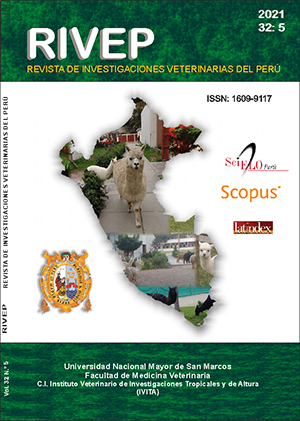Behavior of Rhipicephalus sanguineus infestation in dogs from Havana, Cuba
DOI:
https://doi.org/10.15381/rivep.v32i5.17727Keywords:
Rhipicephalus sanguineus, Infestation, Behavior, HavanaAbstract
The behavior of the infestation by Rhipicephalus sanguineus in dogs from three veterinary clinics in Havana was studied between November 2016 and October 2017. In total, 10 533 ticks were collected in 175 of 300 dogs that were examined without discriminating breed, age or sex. In the wet season there was a greater abundance of infestation and a greater number of ticks (p<0.001), greater extent of infestation (p<0.08), and high intensity of infestation (p<0.005). Most of the infested dogs were young, male and of indefined breed. The factors that influenced the behavior of the infestation by R. sanguineus in dogs were breeding and handling.
Downloads
Downloads
Published
Issue
Section
License
Copyright (c) 2021 María Beatriz Rodríguez Alonso, Maylín González Navarrete, Evelyn Leonor Reyes Herrera, Elianny Bravo Salabarría

This work is licensed under a Creative Commons Attribution 4.0 International License.
AUTHORS RETAIN THEIR RIGHTS:
a. Authors retain their trade mark rights and patent, and also on any process or procedure described in the article.
b. Authors retain their right to share, copy, distribute, perform and publicly communicate their article (eg, to place their article in an institutional repository or publish it in a book), with an acknowledgment of its initial publication in the Revista de Investigaciones Veterinarias del Perú (RIVEP).
c. Authors retain theirs right to make a subsequent publication of their work, to use the article or any part thereof (eg a compilation of his papers, lecture notes, thesis, or a book), always indicating the source of publication (the originator of the work, journal, volume, number and date).



